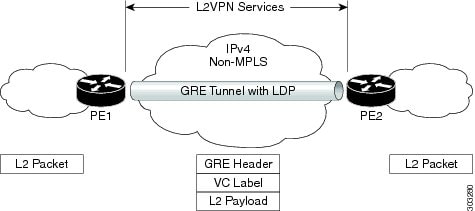Information About MPLS Layer 2 VPN over GRE
The MPLS Layer 2 VPN over GRE feature provides a mechanism for tunneling Multiprotocol Label Switching (MPLS) packets over non-MPLS networks. This feature allows you to create a generic routing encapsulation (GRE) tunnel across a non-MPLS network. The MPLS packets are encapsulated within the GRE tunnel packets, and the encapsulated packets traverse the non-MPLS network through the GRE tunnel. When GRE tunnel packets are received at the other side of the non-MPLS network, the GRE tunnel packet header is removed and the inner MPLS packet is forwarded to its final destination.
To configure MPLS Layer 2 VPN over GRE, you must have configured either Virtual Private LAN Service (VPLS) or EoMPLS (Ethernet over MPLS).
Types of Tunneling Configurations
The following sections provide information about the different types of tunneling configurations that are supported.
PE-to-PE Tunneling
The provider edge-to-provider edge (PE-to-PE) tunneling configuration provides a scalable way to connect multiple customer networks across a non-MPLS network. With this configuration, traffic that is destined to multiple customer networks is multiplexed through a single GRE tunnel.
The PE device on one side of the non-MPLS network uses the routing protocols (that operate within the non-MPLS network) to learn about the PE device on the other side of the non-MPLS network. The learned routes that are established between the PE devices are then stored in the main or default routing table.
The opposing PE device uses Border Gateway Protocol (BGP) to learn about the routes that are associated with the customer networks that are behind the PE devices. These learned routes are not known to the non-MPLS network.
PE-to-PE Tunneling shows an end-to-end IP core from one PE device to another through the GRE tunnel that spans the non-MPLS network.

P-to-PE Tunneling
P-to-PE Tunneling shows a method of connecting two MPLS segments (P2 to PE2) across a non-MPLS network. In this configuration, MPLS traffic that is destined to the other side of the non-MPLS network is sent through a single GRE tunnel.

P-to-P Tunneling
P-to-P Tunneling shows a method of connecting two MPLS segments (P1 to P2) across a non-MPLS network. In this configuration, MPLS traffic that is destined to the other side of the non-MPLS network is sent through a single GRE tunnel.

 Feedback
Feedback